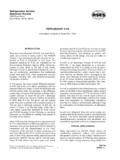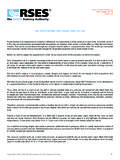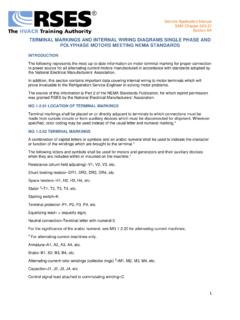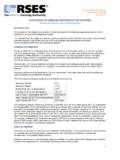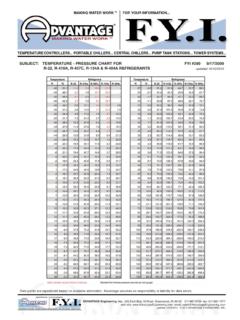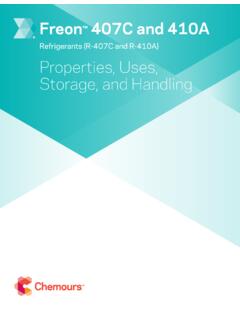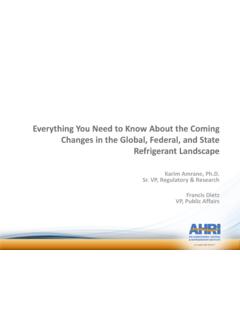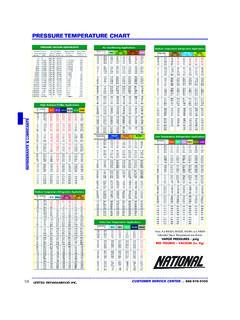Transcription of UNDERSTANDING REFRIGERANT TABLES
1 Refrigeration Service Engineers Society 1666 Rand Road Des Plaines, Illinois 60016. UNDERSTANDING REFRIGERANT TABLES . INTRODUCTION setting of controls A Mollier diagram is a graphical representation of the checking temperature according to pressure properties of a REFRIGERANT , generally in terms of enthalpy and entropy. A familiarity with these dia- computing correct head pressure for a specific grams will make this chapter easier. An understand- set of operating conditions ing of the pressure-temperature relationship of refrigerants as they pass through the refrigeration setting expansion valve superheat compression cycle also will help you as you study this chapter on REFRIGERANT TABLES . noting pressure drop Part of this chapter deals with a REFRIGERANT (R-22) evaluating REFRIGERANT capacities of cylinders and that will soon be phased out of production.
2 However, receivers as a service technician you may continue to come across it for years to come. Be prepared remember estimating compressor capacity that good troubleshooting requires a thorough under- standing of the basics. estimating normal discharge temperature, etc. Table 1, on pages 4 and 5, shows the properties of The table at the end of this chapter shows the prop- R-22 at saturation. It will be used in the examples that erties at saturation of R- 410a . (Trade names are not follow. R-22 will soon be phased out, so you will not used.) The data contained in these TABLES are taken see it as much as you do other refrigerants in the from the best available sources, and are as accurate future. However, all other REFRIGERANT TABLES work as possible. Note that temperature steps are in small essentially the same way as the R-22 example. increments.
3 Thus, you can use them with a close degree of accuracy. The values listed in Table 1 for This chapter will review the older REFRIGERANT (R-22) R-22 are used for the example calculations. The fig- first, and then refer to one of the newer replacement ures are arranged in columns, each with an appro- refrigerants (R- 410a ). As you study their characteris- priate heading. Each column is discussed in the tics, known problems, limitations, etc., remember that following sections. this is a field of rapid change. It is your responsibility to keep current. This can be done only by constant COLUMN 1: TEMPERATURE. review of the latest technical material. The saturation temperatures start with the lowest USING TABLES TO DETERMINE PROPERTIES temperature at which the subject REFRIGERANT might be AT SATURATION used. They continue in small increments through the ranges in which accuracy is most essential.
4 They go REFRIGERANT TABLES have many practical uses for the up to the highest temperature for which properties at competent service technician. Like gauges, test saturation are known and available. instruments, and thermometers, they are valuable tools. Some of the things that you can determine by All saturation properties are based on saturation tem- using REFRIGERANT TABLES include: peratures. Therefore, the temperatures that you see 2005 by the Refrigeration Service Engineers Society, Des Plaines, IL 620-113. Supplement to the Refrigeration Service Engineers Society. 1 Section 3 p listed in Column 1 are the reference points in most entering and leaving air temperatures of an air- uses of REFRIGERANT TABLES . Saturated refers to the con- cooled condenser dition of a liquid at its boiling temperature, and of a vapor at its condensing temperature.
5 Inlet and outlet water temperatures of a water- cooled condenser COLUMNS 2 AND 3: PRESSURE. the temperature of the liquid REFRIGERANT leaving Column 2 lists the absolute pressures (psia) and the condenser. Column 3 lists the gauge pressures (psig) of the sat- urated REFRIGERANT at the corresponding Fahrenheit Saturation temperatures and corresponding pres- temperature. An asterisk (*) indicates inches of mer- sures are always the same for a particular refriger- cury (in. Hg) vacuum. This unit of measurement is ant. Thus, data in Columns 1 and 3 can be used to used up to atmospheric pressure, or zero pounds of set low-pressure controls, high-pressure cut-outs, gauge pressure. Pressures above 0 psig are shown thermostats, and similar control devices. You can use in psig. a thermometer to determine pressure. You can use a pressure gauge to determine temperature.
6 But To convert gauge pressures above 0 psig to absolute remember this only works if the REFRIGERANT is at pressures (psia), simply add To convert pres- saturation. It will not hold true if the liquid is sub- sures below 0 psig (that is, those values preceded by cooled below the saturation temperature shown in an asterisk) to absolute pressures, you must subtract the appropriate table. The same thing applies to a the (in. Hg) vacuum from Then multiply the vapor superheated above the saturation temperature result by , or roughly 50%. The vacuum and shown in the same table. pressure values in Columns 2 and 3 are those at saturation that correspond to the temperatures in COLUMN 4: LIQUID DENSITY. Column 1. Liquids vary in their density (weight per cubic foot). For example, assume that the temperature of boiling Most refrigerants in liquid form have higher densities R-22 in an evaporator is 50 F.
7 Then the evaporator than water (that is, they have specific gravities above pressure is in. Hg vacuum, or psia ). The densities of refrigerants also vary with their ( = = ). This is temperatures. As a rule, liquids expand as they also the low-side pressure, assuming there is no become warmer. Thus, liquid densities at higher pressure drop. If there is a 2-psig pressure drop temperatures are less than at lower temperatures. (about in. Hg), the suction pressure will be about 14 in. Hg, or psia. If you know the internal volume of a REFRIGERANT con- tainer, such as a cylinder or receiver, you can easily You can also use Column 3 to find the saturation find how much liquid REFRIGERANT it will hold. Simply temperature that corresponds to a gauge reading. multiply the internal volume of the container in cubic For example, a compound gauge at the evaporator feet (ft3) by the density of the liquid REFRIGERANT at a may read psig.
8 Then the temperature of the boil- selected temperature. The answer is the number of ing REFRIGERANT is 40 F. This is usually considered the pounds of liquid that the given container will hold evaporator temperature. Caution: If the gauge is (completely liquid-full) at that temperature. located at the compressor, make an allowance for pressure drop in the suction line. There is another way to find the same answer. Instead of multiplying by the density, divide by the specific vol- You can also check condenser pressure-temperature ume at the same temperature. For example, say that values by using Column 3. A discharge pressure of a receiver has an internal volume of ft3. Multiply 226 psig with R-22, for example, means that the by (the density of R-22 at 70 F). The normal condensing temperature is 110 F. Note, how- answer is a total liquid capacity of lb of R-22.
9 Ever, that the condensing temperature should not be at 70 F. You get the same answer if you divide by the confused with: specific volume of liquid For R-22 at 70 F, the specific 2. volume is ft3/lb. And divided by Columns 6 and 8 show the enthalpy values for liquid equals lb. and vapor at Column 1 temperatures above 40 F. Vapor heat content values, however, include the Caution: Liquid-full components of a refrigeration latent heat value shown in Column 7. This will be dis- system will build up hydrostatic pressure with an cussed shortly. The heat content of liquid is sensible increase in temperature. They can burst or explode, heat. In low-temperature areas, it amounts to about the same as a liquid-full cylinder. Btu per pound per degree Fahrenheit (Btu/lb/ F). for R-22. It gradually increases until at liquid-line COLUMN 5: VAPOR VOLUME temperatures it is about Btu/lb/ F.
10 The values listed in Column 4 are specific volumes. The heat content shown in Column 6 is the amount They are the reciprocals of the density values. A good of heat (in Btu) in a pound of saturated liquid. Values example is the liquid density of R-22 at 40 F. Column are based on the assumption that the saturated liquid 4 shows it to be lb/ft3. Divide 1 by to get at 40 F has no sensible heat, which is not com- the reciprocal, This is the specific volume pletely true, of course. Even liquid at 100 F still has of liquid R-22 at 40 F. The same is true of saturated some heat in it. To be completely accurate, these vapor at 40 F. The density is lb/ft3. The specific values would have to be based on absolute zero. volume is ft3/lb (1 = ). This, however, is not really necessary. The purpose of the table is simply to find out how much heat is Thus, the volume value in Column 5 is the reciprocal required to warm a pound of liquid REFRIGERANT from of the density value of the saturated vapor.
